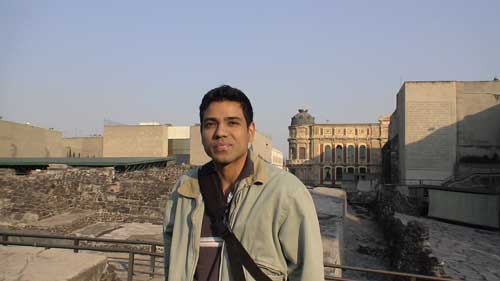
| Introduction . . . | Next Page . . . |
 |
| Standing at the Templo Mayor in the center of Tenochtitlan, the capitol city of the Aztecs and subsequently the Zocalo, or base, of Mexico City. The temple is being researched and excavated but you can walk through the ruins and view the museum. |
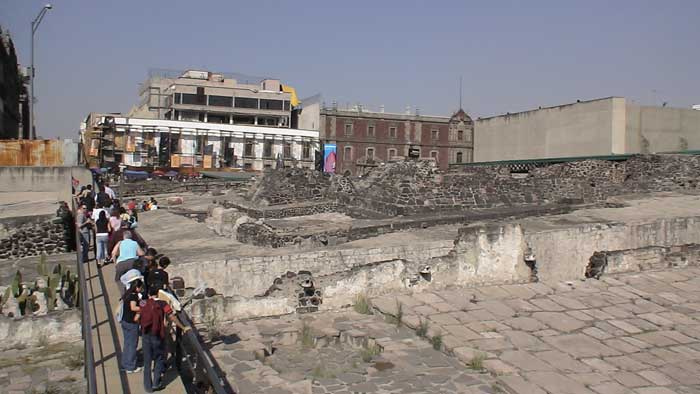 |
| Another view of the Templo Mayor. The Aztecs built new layers of the temple over previous constructions. |
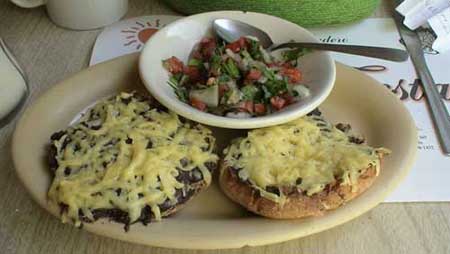 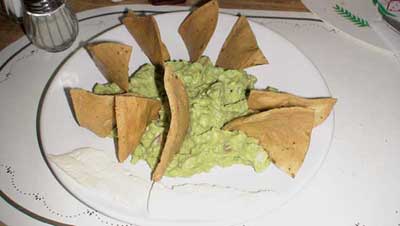 |
| Molletes is soft bread, served with beans, cheese and a mild salsa of tomatoes, onions and cilantro. All the ingredients melt together to form a sponge-like texture which is easily digestible. A fruit platter serves as a prequel with melons, strawberries, bananas, etc. and topped with tapioca seeds. The next picture is a plate of guacamole I ate at Hotel Isabel where I stayed for a few nights when I first arrived. Even an average plate of guacamole tastes superb. |
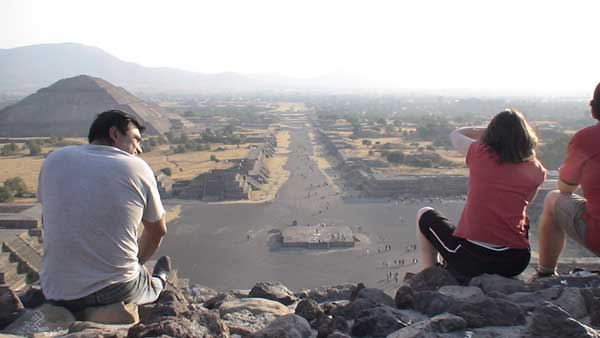 |
| A view from the top of the Pyramid of the Moon in Teotihuacan. You can look down the Avenue of the Dead and see the Pyramid of the Sun, the third largest pyramid in the world. |
 |
Pyramid of the Moon. Teotihuacan, Mexico |
My journey started in Tijuana where my parents dropped me off after crossing the border. After some delay finding the bus station and having my first conversation in Spanish after a long time, I was on my way to Mexico City. Tijuana serves as a gateway for people in the Southwest of the United States to experience an entirely different land and culture. It was nice to be able to cross the border on the road. A bus ticket didn’t seem that much cheaper from Tijuana to Mexico City in compensation for the time lost, 40 hours on a bus vs. 4 hours on a plane. Furthermore, the north of Mexico is not as densely populated as the southern parts, and many of the interesting points that I was eager to visit where in the Yucatan and Chiapas. I broke my journey in Chihuahua. Chihuahua can seem like an average American town, with a festive and shopping atmosphere, probably because I arrived around Christmas. The Mexican high dessert stretches at the periphery and most of the buildings outside of downtown are just one story stone structures, something I would become familiar with in Central America. I stayed at Hotel Maria Dolores, straight from the guidebook, and the staff did their best to answer my questions. The only reason I had stopped in Chihuahua was to take the Copper Canyon Railway to Los Mochis, which is a full day train ride through deep canyons and meadows much like the Grand Canyon in the United States, and is said to be even more impressive than that. Unfortunately, in the winter months daylight is short, and numerous people informed me that the best scenery was towards the Los Mochis side. If I left from Chihuahua, I would arrive at night in the most scenic areas and would not be able to see anything. Los Mochis is a better departure city to take the beautiful Copper Canyon Railway. I visited the bank and did some other errands in downtown. A vivacious tourist guide from the tourism office in the Palacio de Gobierno filled me in on how to proceed to Mexico City and other points of interest in the city. I walked to the former house of Pancho Villa, which is now a Museum of the Mexican Revolution. Here you can see many remnants from his household, including antique household furniture, ancient canons, guns and even the “bullet-riddled black Dodge” that Pancho Villa was driving when he was assassinated. I had been banking on eating at Nutry Vida, a vegetarian restaurant, but when I came to the address it appeared the establishment had closed and instead another restaurant was in its place. I roamed around looking for a decent place and finally found a Subway. Thankfully, for the rest of my journey I found ample Mexican cuisine to satiate my desire. Another overnight bus, and within 20 hours I had arrived at the great Mexico City. Some say the biggest city in the world and they are probably right, housing one fifth of Mexico population and with numerous barrios, suburbs and extensions. There is more than meets the eye. From the bus stand I paid a hefty $8 dollars to take a taxi to the Centro Historico. Little did I know that for 20 cents I could be there in about the same time if I used the metro. The Centro Historico contains many cultural landmarks and ancient buildings. It is the heart of the city and a great place to meet other backpackers. I checked in at Hotel Isabel and this is where I met my first travel companion, Nic from the UK. Hotel Isabel has clean private rooms with colonial architecture and décor for about $12. I was pretty happy to get off the bus and have a room. The city has a pretty good metro system, while not as spic and span as some Asian cities, serves most of the important places you might need to go such as Xochimilco and Belles Artes. It can get crowded during rush hour and then you can experience what Mexican life is for many locals as drone-like oceans of people will be heading in one direction during evening or morning hours. Certainly nothing compared to Mumbai trains. December is still warm but nights and mornings can be chilly. The locals seem to break out the scarves and gloves when the temperature drops anywhere below 70 degrees. Due to the high altitude or the pollution, I found doing yoga or climbing a flight of stairs more taxing than usual, especially in the underground metro. I walked up and down the ancient streets, spending most of my time on Ave. Cinco de Mayo and Ave. Madero, both chock full of shops and restaurants. I was fortunate to be in the Zocalo on Christmas Day and saw the square festooned with Christmas lights and a crowd of sellers hawking everything from tender coconut juice, indigenous handicrafts to cotton candy. Indigenous dance performances take place regularly in the Zocalo. There are two fairly good vegetarian restaurants in the Centro Historico, both located near each other and Nic and I sampled meals from both. It didn’t take long for me to get a sense of direction in the small grid of streets. I enjoyed walking near the peddlers playing hand cranked harmoniums, sellers vending everything from authentic handicrafts to frozen yoghurt, while suit and tie types entered the Supreme Court or other office buildings. Volkswagen bugs taxis pepper the brick roads and you are never far from fresh "jugos y licuados." The Templo Mayor in the Zocalo was once the center of the Aztec city Tenochtitlan before the Spanish arrived. The Spanish from 1519-1521, brought the Aztec empire to its knees and subjugated or killed most of the native population. Many other Native Americans died by diseases brought by the Europeans. The Templo Mayor is a work in progress but you can see shrines to Huizilopochtli, the Aztec tribal god and the water god, Tlaloc, among others. “The temple is thought to be the exact spot where the Aztecs saw their symbolic eagle, with a snake in its beak, perching on a cactus – the symbol of Mexico today. In Aztec belief this was the center of the universe.” I was glad I paid the entry fee to view the temple and the museum. The temple is quite vast compared to what you can see from the outside, the walkway tapers around inside and the excavations dig deep under several levels. The museum houses an excellent collection of masks, some striking, other terrible, the Stone of the Suns and hundreds of other stones, paintings and carvings found in the area. However, my favorite musuem would have to the archeological museum in Mexico City, where I spent a whole day. Here you feel immersed in the different civilizations and time periods because the whole museum is thematically arranged, with proper décor to match. From prehistoric times all the way to present day, the exhibits are carefully arranged in sections that you can peruse in small doses. The whole musuem is just huge and I didn't even have time to explore the upper level. Then it was on to Teotihuacan with Nic, which is a must see stop away from Mexico City. Teotihuacan was once the religious center of Mexico with two giant sun and moon pyramids. The builders of the city are unknown, and when the Aztecs discovered the area, they though it was built by the gods. The area is cleanly maintained and many locals from Mexico City journey out here for an easy going romantic interlude from the hectic city life. From atop the pyramids you get a wonderful view of the valley and the accompanying mountains. Unfortunately, the museum here was closed, but it would have been nice to gather more information about the site. The moon pyramid is curious because on the top are sharply etched stones that make it difficult to walk over. I nearly twisted my ankle scrambling about for better views. A long gravel road called the Calzada de Los Muertos “Avenue of the Dead,” leads to the pyramids with ruins on either side. The area was mostly hassle free. One hawker tried to sell something to Nic by saying, "for your mother in law." |
Movie Clip
Please press play
You may need to download quicktime here
| One of the best anthropology museums in the world, artifacts from the indigenous people of Mexico are arranged in a vast plaza of thematic rooms. |
| Next Page . . . |